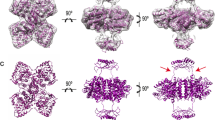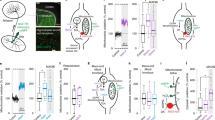Abstract
Tyrosine hydroxylase (tyrosine 3-monoxygenase, EC 1.14.16.2, TH) catalyses the rate limiting step of catecholamine biosynthesis, In vitro, TH from central dopaminergic1–4 as well as from central5,6 and peripheral6,7 noradrenergic neurones can be activated by a cyclic AMP-dependent phosphorylation process and several authors7–9 have proposed that this process can be responsible for the in vivo activation of TH resulting from the electrical stimulation of these neurones. However, this is unlikely to be the case for TH in central dopaminergic neurones because depolarization produces an enzyme activation which is additive with that due to the cyclic AMP-dependent phosphorylation process10–12. In the case of tryptophan hydroxylase in central serotoninergic neurones, recent evidence indicates that a Ca2+-dependent instead of a cyclic AMP-dependent phosphorylation process is responsible for the increased enzyme activity triggered by depolarization13. This finding led us to investigate whether a Ca2+-dependent phosphorylation process also accounts for the activation of TH inside depolarized dopaminergic terminals. We found that soluble TH from the rat striatum could be activated by a Ca2+-dependent process in optimal conditions for producing the phosphorylation of proteins. This activation corresponded exactly to that resulting from the incubation of striatal slices in K+-enriched medium and indeed TH activity from depolarized dopaminergic terminals could not be further stimulated by Ca2+-dependent phosphorylating conditions. In contrast, in situ TH activation by cyclic AMP-dependent phosphorylation (triggered by dibutyryl cyclic AMP or forskolin) did not prevent subsequent stimulation by Ca2+-dependent phosphorylation. These findings suggest that TH activation in depolarized dopaminergic terminals involves a Ca2+-dependent phosphorylation process similar to that controlling tryptophan hydroxylase activity in serotoninergic neurones.
This is a preview of subscription content, access via your institution
Access options
Subscribe to this journal
Receive 51 print issues and online access
$199.00 per year
only $3.90 per issue
Buy this article
- Purchase on Springer Link
- Instant access to full article PDF
Prices may be subject to local taxes which are calculated during checkout
Similar content being viewed by others
References
Lovenberg, W., Bruckwick, E. A. & Hanbauer, I. Proc. natn. Acad. Sci. U.S.A. 72, 2955–2958 (1975).
Joh, T. H., Park, D. H. & Reis, D. J. Proc. natn. Acad. Sci. U.S.A. 75, 4744–4748 (1978).
Vrana, K. E., Allhiser, C. L. & Roskoski, R. Jr, J. Neurochem. 36, 92–100 (1981).
Pollock, R. J., Kapatos, G. & Kaufman, S. J. Neurochem. 37, 855–860 (1981).
Acheson, A. L., Kapatos, G. & Zigmond, M. J. Life Sci. 28, 1407–1420 (1981).
Weiner, N. Aromatic Amino Acid Hydroxylases and Mental Disease (ed. Youdim, M. B. H.) 141–190 (Wiley, Chichester, 1979).
Weiner, N., Lee, F. L., Meligeni, J. & Tank, A. W. Function and Regulation of Monoamine Enzymes: Basic and Clinical Aspects (eds Usdin, E., Weiner, N. & Youdim, M. B. H.) 3–14 (Macmillan, London, 1981).
Murrin, L. C., Morgenroth, V. H. III & Roth, R. H. Molec. Pharmac. 12, 1070–1081 (1976).
Roth, R. H. & Salzman, P. M. Structure and Function of Monoamine Enzymes (eds Usdin, E., Weiner, N. & Youdim, M. B, H.) 149–168 (Dekker, New York, 1977).
Goldstein, M., Bronaugh, R. L., Ebstein, B. & Roberge, C. Brain Res. 109, 563–574 (1976).
Bustos, G. & Roth, R. H. Biochem. Pharmac. 28, 3026–3028 (1979).
Simon, J. R. & Roth, R. H. Molec. Pharmac. 16, 224–233 (1979).
Hamon, M., Bourgoin, S., Artaud, F. & Glowinski, J. J. Neurochem. 33, 1031–1042 (1979).
Seamon, K. B., Padgett, W. & Daly, J. W. Proc. natn. Acad. Sci. U.S.A. 78, 3363–3367 (1981).
Yamauchi, T. & Fujisawa, H. J. biol. Chem. 254, 6408–6413 (1979).
Kakiuchi, S., Rail, T. W. & Mcllwain, H. J. Neurochem. 16, 485–491 (1969).
Hamon, M., Bourgoin, S., Artaud, F. & Héry, F. J. Neurochem. 28, 811–818 (1977).
Levin, R. M. & Weiss, B. Molec. Pharmac. 12, 581–589 (1976).
Raese, J. D., Makk, G. & Barchas, J. D. Function and Regulation of Monoamine Enzymes: Basic and Clinical Aspects (eds Usdin, E., Weiner, N. & Youdim, M. B. H.) 105–114 (Macmillan, London, 1981).
Yamauchi, T. & Fujisawa, H. Biochem. biophys. Res. Commun. 100, 807–813 (1981).
Author information
Authors and Affiliations
Rights and permissions
About this article
Cite this article
El Mestikawy, S., Glowinski, J. & Hamon, M. Tyrosine hydroxylase activation in depolarized dopaminergic terminals—involvement of Ca2+ -dependent phosphorylation. Nature 302, 830–832 (1983). https://doi.org/10.1038/302830a0
Received:
Accepted:
Issue Date:
DOI: https://doi.org/10.1038/302830a0
This article is cited by
-
A core-satellite-like nanoassembly reverses a decisive tyrosine hydroxylase loss in degenerative dopaminergic neurons
Nano Research (2023)
-
Dopaminergic function in rat brain after oral administration of calcium-channel blockers or haloperidol. A microdialysis study
Journal of Neural Transmission (1994)
-
Activation of striatal tyrosine hydroxylase by neurocatin, a neuroregulator from mammalian brain
Neurochemical Research (1992)
-
Effects of HA1077, an intracellular calcium antagonist, on neurotransmitter metabolism in rat brainIn Vivo
Metabolic Brain Disease (1991)
Comments
By submitting a comment you agree to abide by our Terms and Community Guidelines. If you find something abusive or that does not comply with our terms or guidelines please flag it as inappropriate.



